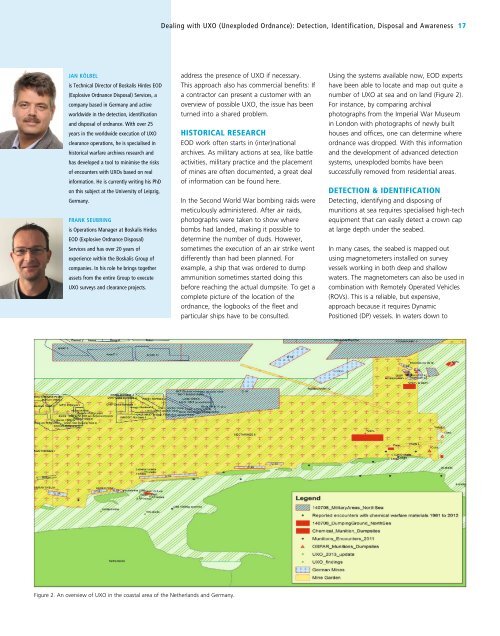Create successful ePaper yourself
Turn your PDF publications into a flip-book with our unique Google optimized e-Paper software.
Dealing with UXO (Unexploded Ordnance): Detection, Identification, Disposal and Awareness 17<br />
JAN KÖLBEL<br />
is Technical Director of Boskalis Hirdes EOD<br />
(Explosive Ordnance Disposal) Services, a<br />
company based in Germany and active<br />
worldwide in the detection, identification<br />
and disposal of ordnance. With over 25<br />
years in the worldwide execution of UXO<br />
clearance operations, he is specialised in<br />
historical warfare archives research and<br />
has developed a tool to minimise the risks<br />
of encounters with UXOs based on real<br />
information. He is currently writing his PhD<br />
on this subject at the University of Leipzig,<br />
Germany.<br />
FRANK SEUBRING<br />
is Operations Manager at Boskalis Hirdes<br />
EOD (Explosive Ordnance Disposal)<br />
Services and has over 20 years of<br />
experience within the Boskalis Group of<br />
companies. In his role he brings together<br />
assets from the entire Group to execute<br />
UXO surveys and clearance projects.<br />
address the presence of UXO if necessary.<br />
This approach also has commercial benefits: If<br />
a contractor can present a customer with an<br />
overview of possible UXO, the issue has been<br />
turned into a shared problem.<br />
HISTORICAL RESEARCH<br />
EOD work often starts in (inter)national<br />
archives. As military actions at sea, like battle<br />
activities, military practice and the placement<br />
of mines are often documented, a great deal<br />
of information can be found here.<br />
In the Second World War bombing raids were<br />
meticulously administered. After air raids,<br />
photographs were taken to show where<br />
bombs had landed, making it possible to<br />
determine the number of duds. However,<br />
sometimes the execution of an air strike went<br />
differently than had been planned. For<br />
example, a ship that was ordered to dump<br />
ammunition sometimes started doing this<br />
before reaching the actual dumpsite. To get a<br />
complete picture of the location of the<br />
ordnance, the logbooks of the fleet and<br />
particular ships have to be consulted.<br />
Using the systems available now, EOD experts<br />
have been able to locate and map out quite a<br />
number of UXO at sea and on land (Figure 2).<br />
For instance, by comparing archival<br />
photographs from the Imperial War Museum<br />
in London with photographs of newly built<br />
houses and offices, one can determine where<br />
ordnance was dropped. With this information<br />
and the development of advanced detection<br />
systems, unexploded bombs have been<br />
successfully removed from residential areas.<br />
DETECTION & IDENTIFICATION<br />
Detecting, identifying and disposing of<br />
munitions at sea requires specialised high-tech<br />
equipment that can easily detect a crown cap<br />
at large depth under the seabed.<br />
In many cases, the seabed is mapped out<br />
using magnetometers installed on survey<br />
vessels working in both deep and shallow<br />
waters. The magnetometers can also be used in<br />
combination with Remotely Operated Vehicles<br />
(ROVs). This is a reliable, but expensive,<br />
approach because it requires Dynamic<br />
Positioned (DP) vessels. In waters down to<br />
Figure 2. An overview of UXO in the coastal area of the Netherlands and Germany.


